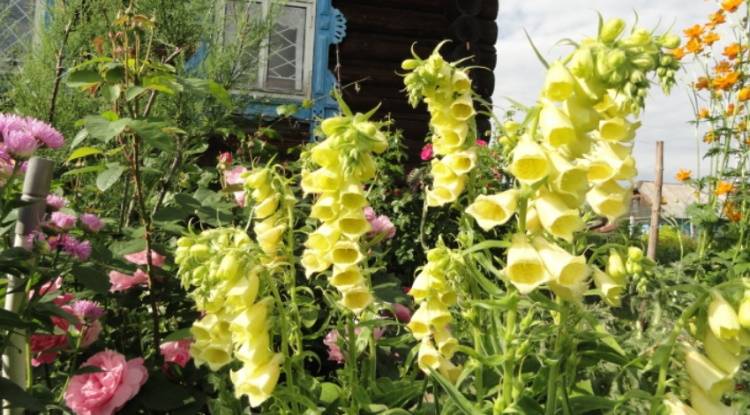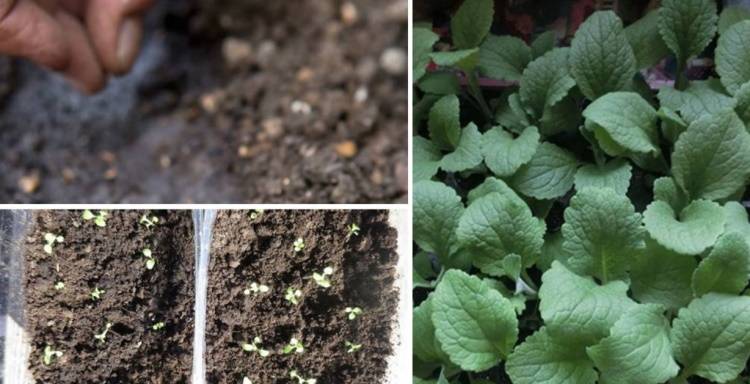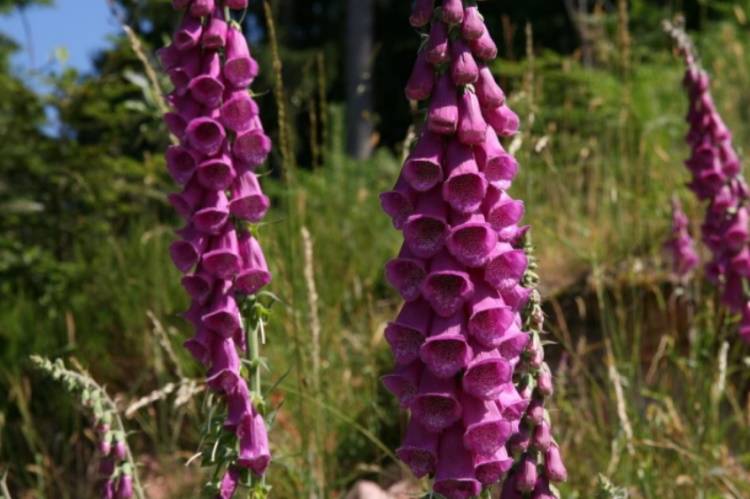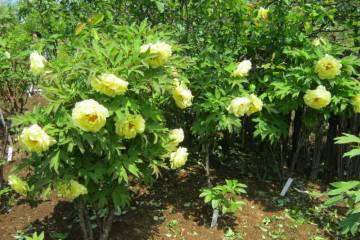Perennial digitalis - the best types and varieties for giving
Content:
Foxglove is a perennial crop, but with age it loses its ability to bloom, so it is renewed every two to three years. In Latin, the name sounds like "Digitalis", which means "finger" or "thimble". Below are all the secrets of growing this flower.
What perennial foxgloves look like
The foxglove flower is subdivided into 3 dozen species. According to the description, it resembles a spikelet of wheat with bell flowers along the entire top of the stem, collected in a brush. The plant is unpretentious. In the wild, it can be found on forest edges, in bushes, in a meadow, along rivers and roads, in a river floodplain and on rocky soil.
The plant has a hard, high stem, reaching a height of 1.5 m, on which large oval-shaped leaves of bright green color are located, from below they are covered with an edging of hairs. The upper part of the stem can branch out.
Foxglove is a biennial, belongs to the family of dicotyledonous plants of the Podorozhnikovs, earlier it was considered the Norichnikovs family.
Briefly about the history of appearance
A German legend tells about the origin of the plant, which resembles thimbles. It tells about a poor girl who had only thimbles left from her dead mother, and even those were stolen by an evil stepmother and buried in the garden. In consolation of the poor orphan, amazing flowers grew out of them, their shape similar to the thimbles dear to her heart.
The British have composed their legend about a beautiful flower. It tells about the sad existence of foxes, from whose tails amulets were made, thereby mercilessly exterminating them. The Lord took pity on the poor animals and planted plants with bells throughout the forest, which warned the foxes of the approach of the hunters.
According to another legend, forest fairies gave flowers to foxes, so that, putting them on their paws, they could silently make their way into the chicken coop for prey.
Plant characteristics
Digitalis is a tall, erect herb. The leaves are dark green above, velvety to the touch, grayish below with many fine hairs. The flower was widespread in the western and central regions of Europe, in some places in the Russian Federation, Ukraine, Belarus, in the northern Caucasus, in the Mediterranean countries.
Harm and benefit
Digitalis is a poisonous plant, it contains many glycosides of plant origin. Organic substances extracted from flowers and leaves are much stronger than their chemical counterparts. Even in ancient times, arrowheads were rubbed with poisonous juice to defeat the enemy.
In Egypt and Rome, glycosides were used in folk medicine, they stimulated the cardiac cycle. In the XVII century. foxglove has been successfully treated for dropsy of the body.
In the XVIII century. pure digitoxin was isolated from it, which is still used in the treatment of myocardial dysfunction. Unlike digoxin, it is excreted through the liver, not the kidneys, which is important for people with kidney failure.
In order to identify the activity of hazardous substances in the leaves of foxglove purpurea, the State Pharmacopoeia (State Pharmacopoeia) constantly conducts experiments on frogs and cats in order to better understand the effect of the drug on human cardiac activity.
Classification of species of perennial digitalis
Digitalis, as the flower is also called, is divided into 3 subgroups depending on the growth of the stem:
- dwarf. Has a height of up to 60 cm;
- medium-sized. Height up to 1 m;
- tall or giant. It can reach two meters in height.
There are over 30 types of foxglove.
Purple (Digitalis purpurea)
Digitalis purpurea has a straight hairy stem. The leaves are large green in the shape of an oval. Closer to the ground, they create a rosette, attached to the stem with long cuttings. The large leaves are velvety to the touch, fluffy below.
The botanical species of flowers has a wide range of colors - all shades of white, cream, pale pink, bright red. The inflorescences are collected in a brush. It begins to bloom in the second year after planting from early summer to September.
Large-flowered (Digitalis grandiflora, Digitalis ambigua)
Large-flowered foxglove reaches a height of 100-120 cm. The top of a straight, villi-covered stem is covered with large yellow flowers, the inner side of which is dotted with brown specks.
Rusty (Digitalis ferruginea)
Rusty foxglove, like large-flowered, grows up to 120 cm. Differs in reddish flowers with long fluffy leaves.
Woolly foxglove (Digitalis lanata)
Low-growing variety, no more than 60 cm in height. The stem is dotted with small nondescript pale yellow flowers.
Yellow (Digitalis lutea)
This variety is undersized, reaching a height of one meter. Its leaves are narrow, smooth and without fibers, the flowers are whitish or pale yellow in color.
The cultivars that are most popular with horticulturists
Digitalis is in high demand among gardeners and landscape designers.
Camelot Rose
It has an oval-shaped leaf, reaches a height of 80 cm. The color of the flower goes from light purple to dark. Re-blooming can be brown or white. Loves humus-rich soil, well-lit areas and partial shade.
Sugar Plume
The hybrid has large pale lilac flowers, painted inside with contrasting dark spots. Stem height reaches 120 cm. Loves sunny and slightly shaded areas.
Dalmatian Purple
A frost-resistant variety with purple-lilac flowers. Prefers diffused light, well-moisturized, humus-rich soil.
Red dwarf
The plant resists drought and frost well. Large-flowered variety with red flowers forming large inflorescences. Loves sunlight and loose, well-permeable soil.
Alba
Winter-hardy, unpretentious variety. The stem is up to 1.5 m high. The length of the flower racemes is 80 cm. The flowers are white with red spots. Prefers sufficiently moist, sunny areas.
Mirabella
Combines several colors: cream, pink, red, coral. The stem is 60 cm high.
Pink champagne
It grows up to 120 cm. Flowers of a pale pink shade with dark blotches inside.
Digitalis: planting and care
Perennial foxglove provides for cultivation from seeds and seedlings. Seed propagation is an easier way.
Growing from seeds
Seeds for sowing in the ground are harvested when the bolls of digitalis, while ripening, acquire a brownish-yellowish color. This happens a month after the end of flowering.
Time to board
The most favorable time for planting seeds for seedlings is the first decade of April. After 10-14 days, the first shoots begin to appear from them. If there are 5-6 leaves on them, the sprouts can be transplanted into open ground.
Choice of capacity
For seedlings, seeds are sown in boxes with prepared soil. It is calcined from pests in the oven or microwave. The seeds are placed in shallow moist grooves, lightly sprinkled with earth and covered with foil.
Soil and seed preparation
The soil for seedlings should be loose, well fertilized. For looseness, perlite is added to the ground. River sand and humus are mixed into deciduous and garden soil. Before planting, the seeds are dipped into the water, the ones that have flown are thrown away, since they will not germinate.
Seedling care
When the first leaves appear, the seedlings are thinned out. When 5-6 leaves appear, the sprouts are planted in separate pots. They take care of the seedlings every day: they water, they make sure that there is no stagnation of water, they regularly ventilate the room.
Dive and transfer
It is necessary to plant the bushes in the prepared soil at a distance of 40 cm from each other so that there is no thickening. The dive is performed when the first shoots appear. Planting is carried out in the ground at the end of spring, when there is no threat of frost. In the southern regions, where the heat settles faster, they plant 2-3 weeks earlier.
Planting seeds directly into the ground
Planting and caring for foxgloves in the open field is within the power of even a novice florist. Well-lit, not shaded areas should be chosen for it. Preparing the beds for planting involves loosening and applying nitrogen and potassium fertilizers, humus mixed with lime to the soil.
The grooves are not deepened, the distance between them is left 40 cm. Seeds are sown on the compacted soil, which are sprinkled with sand or earth and watered. For quick germination, the crops can be covered with agrofibre for 10 days from above.
After a month, young shoots are thinned, leaving a distance of 5 cm between them. The second thinning provides for a distance of 25 cm. It is carried out before the onset of autumn.
Root growth
You can propagate by root shoots. She is carefully separated from the common bush and transplanted to a new place. The next year, such a shoot will produce large clusters of flowers.
Dividing the bush
Reproduction by dividing the bush is carried out after it has faded. The bush extracted from the ground is carefully divided into parts and transplanted to new places, previously fertilized and watered with water.
Features of care in the garden
Digitalis has a strong immunity to disease. The plant loves loose, well-fertilized soil. In conditions of stagnant water, it can rot and stop blooming.
Watering
The plant requires frequent watering, but the water should not stagnate, for this, good drainage in the soil should be foreseen in advance.
Mulching
For less drying of the soil, mulching is carried out with dry grass or sawdust.
Loosening
When a crust appears after watering and to destroy weeds, loosening of the soil is required.
Top dressing
Top dressing begins with ammonium nitrate diluted with water in a proportion of 10 g per 10 liters of water. The subsequent ones are carried out with mineral fertilizers 2-3 times per summer.
Transfer
Digitalis has roots located close to the soil surface, so its transplantation does not injure the root system, the plant is easily removed from the ground. It is better to transplant with a lump.
When and how it blooms
The lush bloom of the foxglove attracts both people and insects.
Types of flowers
Digitalis has flowers of irregular shape with a complex internal structure. The insect, getting inside the flower, is completely covered with pollen, which then pollinates other inflorescences. When the foxglove blooms, it seems that the field turns into a brightly motley carpet of all colors of the rainbow.
Flowering period
The plant blooms during the warm season. In place of the dried bunches of bells, after cutting them, new inflorescences are formed.
Changes in care during flowering
During the flowering period, the plant needs additional watering, weeding, and loosening of the soil.
Possible growing problems
The graceful bell does not tolerate stagnant water at the roots. Excess moisture has a detrimental effect on plant growth and flowering.
Pests
Pests are nematodes and aphids, but their mass invasion is extremely rare.
Diseases
The causes of flower fungal diseases are excessive soil moisture, improper care. At the first sign, spraying with fungicides should be carried out.
Signs of improper care
Improper care affects the peduncles. They grow small and inconspicuous. Stagnant water leads to root rot.
Use in landscape design
Digitalis goes well with shrubs and mature trees in the garden landscape. Artificial reservoirs and ponds are decorated with low grades. Foxglove can be used as a tapeworm on an emerald lawn. Its height, extraordinary shape of bright flowers, incessant flowering can decorate any meadow without adding other plants.
The beauty and unusual flowering of digitalis for the whole summer will decorate any meadow in front of the house. The main thing is to plant the flower correctly and provide it with decent care.
























